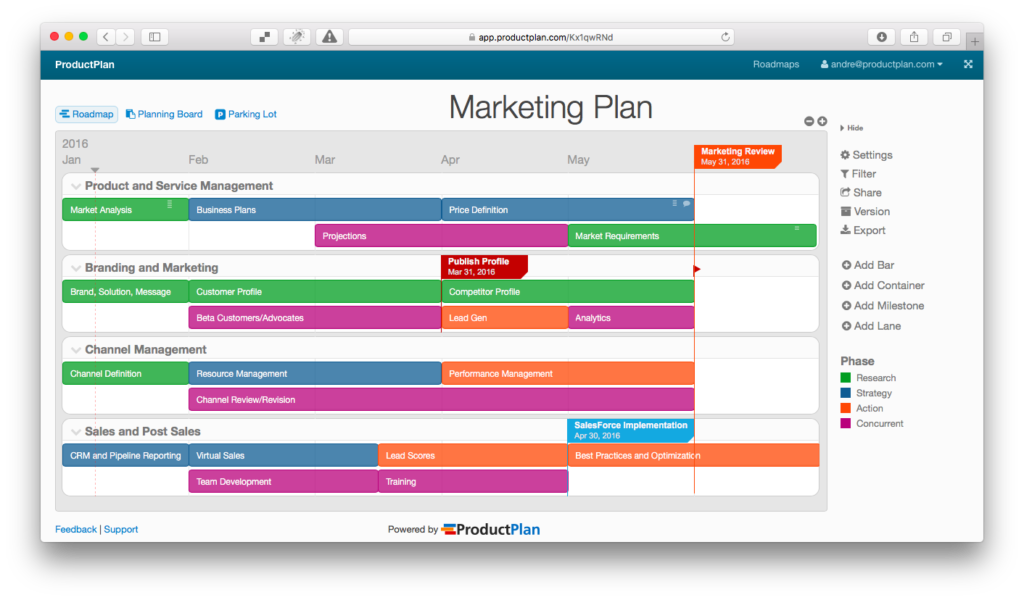Marketing plan examples are all over the web. You can easily find more samples and templates than you could ever need. Just google “marketing plan example.” Go ahead.
A gazillion, right?
In our experience, though, when marketing managers or executives are looking to build a plan, they often have in mind something completely different from what shows up in an Internet search for marketing plan examples.
The typical description of a marketing plan is something akin to a business plan. It’s a long-form, static document that gives a narrative description of the main components of a company’s planned marketing campaign.
Here is an outline given for a typical marketing plan example:
A) Executive Summary
B) Target Customer Overview
C) Competitive Overview and Full SWOT Analysis: Strengths, Weaknesses, Opportunities, Threats
D) Sales and Distribution Plan
In many cases, each of these sections will be several pages long, with detailed explanations of research conducted and data analyzed. At the very early stages of marketing preparation, drafting such a plan can be a useful exercise for a marketer because it can help organize, clarify, and capture that marketer’s strategic thinking.
But our question to you is: Is this the document you will actually use to guide your marketing efforts? Will you refer back to it frequently, and change details whenever new realities emerge? Will you be able to get all of the relevant parties across your company to read it?
Your Marketing Plan Should be a Strategic-Level Roadmap — Not a Detailed Task List, and Not a Book
The problem with a formal, prose-heavy document is that it forces you to represent all of your marketing thinking in a static format. And once you’ve documented all of this high-level strategic thinking, you will be tempted to jump straight into the details. This is why so many marketers who create long-form marketing plans like this then immediately shift into task mode:
- Steve should call the PR firm and get them working on a news release schedule and maybe start prepping a press conference.
- Should we have Jill ask Sales which types of collateral pieces and training assets they’d like us to develop?
- Let’s write up a job description for a Demand Generation Manager so we can get someone in place before the next version of the product is ready.
So, what’s wrong with this? After all, these seem like logical tasks to start executing the company’s marketing plan.
Tweet This:
“Your marketing plan should be a strategic-level roadmap — not a detailed task list, and not a book.”
And while this is true, what has actually happened in the hypothetical scenario above is that the marketer has skipped a vital step. She drafted a prose-heavy marketing plan to capture her strategy on paper — one that few people will actually read and probably no one will ever refer back to — and then moved right into the task-level details.
But how easy will it be for this marketer to tie the details and milestones back to her strategic plan, and to make sure she and her team are always on track throughout the marketing process?
Or, to put this the other way: Won’t it be easy for the marketing team to get so focused on the project management side of things that they lose sight of their larger strategic plan for their marketing efforts? Won’t they drift off track because they’ve forgotten the reasoning behind what they’re doing?
Our advice is to avoid the temptation to jump from drafting your static marketing plan directly into assigning tasks. Instead, we recommend you insert an all-important middle step in your marketing process.
The ideal process looks like this:
First, start with a strategic discussion around your marketing plan. If you’re launching a new company or a new product, this could be a long-form document containing your research and analysis. For established products, it might be a more high-level discussion around mid to long-term goals.
Next — and we believe this is a critical step — develop a working, living document to serve as your strategic-level marketing plan. This plan is your marketing roadmap, an actionable document that you update on a regular basis. As such, you should build this document in a purpose-built roadmap tool.
Here is an example of a marketing roadmap built with ProductPlan. One advantage of using web-based roadmap software is that the plan functions as a living document that the marketer can easily update and share across their organization. For additional examples, check out this post covering three marketing roadmap examples.
 Finally, when you have built your strategic-level, living marketing roadmap, you can start digging into the main themes contained in this roadmap and converting them into specific tasks or assignments. For this step, we recommend you use a different tool — ideally a web-based project management application such as Trello.
Finally, when you have built your strategic-level, living marketing roadmap, you can start digging into the main themes contained in this roadmap and converting them into specific tasks or assignments. For this step, we recommend you use a different tool — ideally a web-based project management application such as Trello.
Why Roadmaps are Important for Marketing Teams
Although marketing campaigns will always differ somewhat from company to company, and often even within the same company from one campaign to the next, there are certain fundamental principles you should always adhere to.
One of those fundamental principles is to develop a high-level strategy before delving into the details. The details — the tasks, the projects, the milestones, the timelines — exist only to serve your team’s larger strategic marketing goals. So you need to determine those strategic objectives first.
The best way to do that is not necessary to write a long narrative document — one that will inevitably need constant updating and risk version-control issues as it is shared across the company. If writing your strategic thinking in this way helps your process, go for it.
But the most important step is to translate that vision into an actionable roadmap that captures your strategic-level marketing objectives — ideally using an easy-to-build, easy-to-update tool. That strategic document then guides your efforts to build out your project task lists.
How do you currently manage and communicate your team’s marketing strategy? We’d love to hear your tips!



